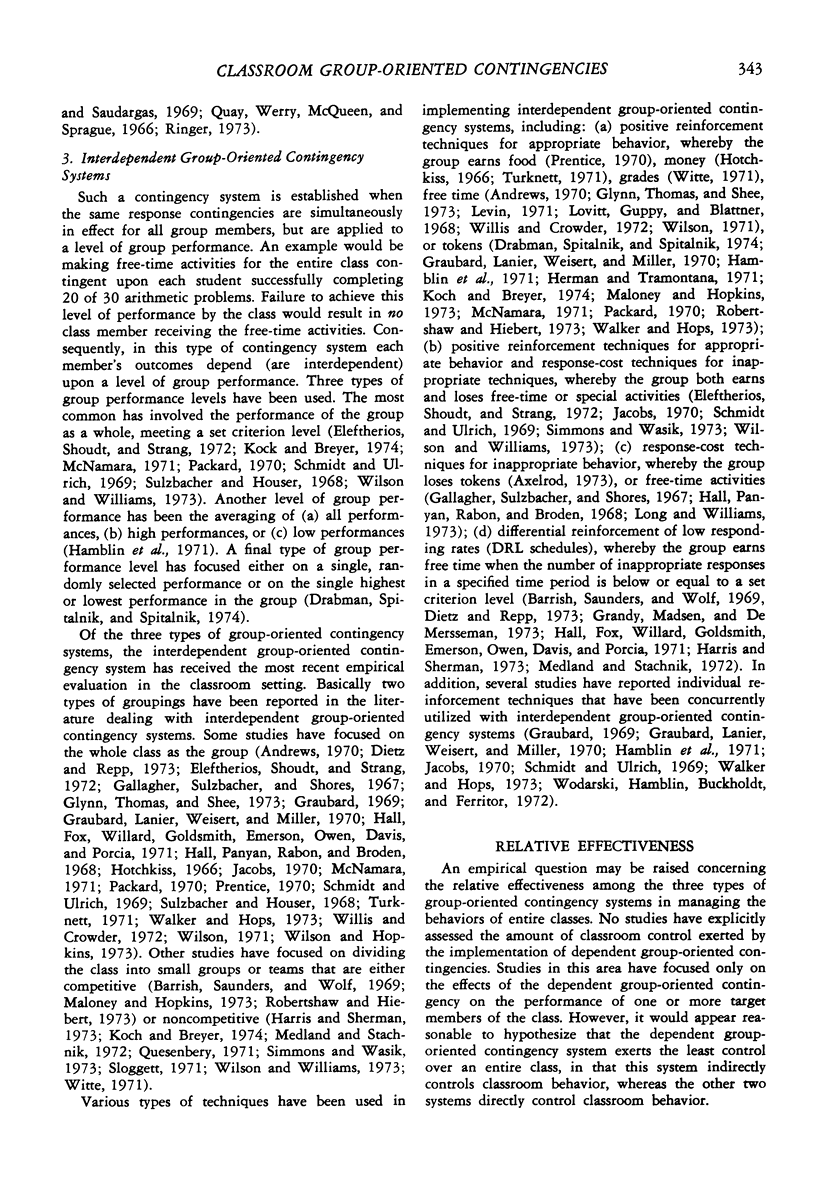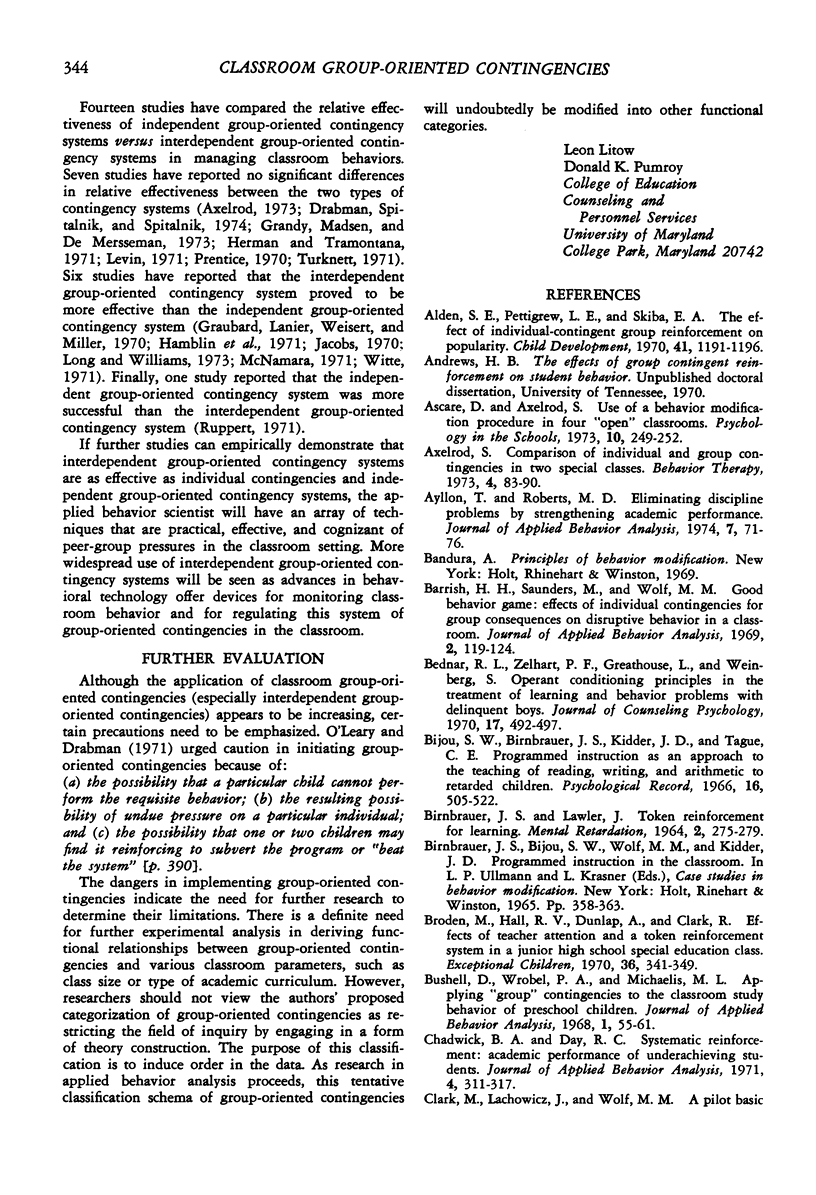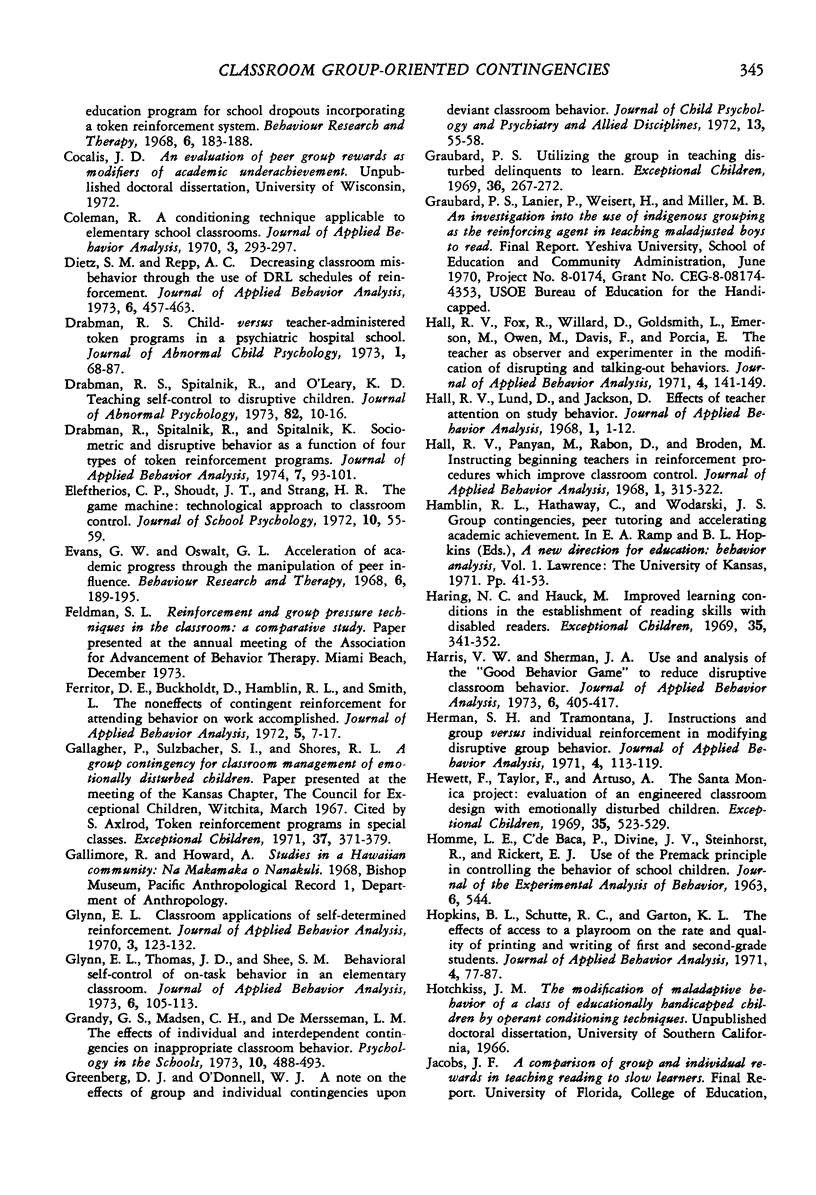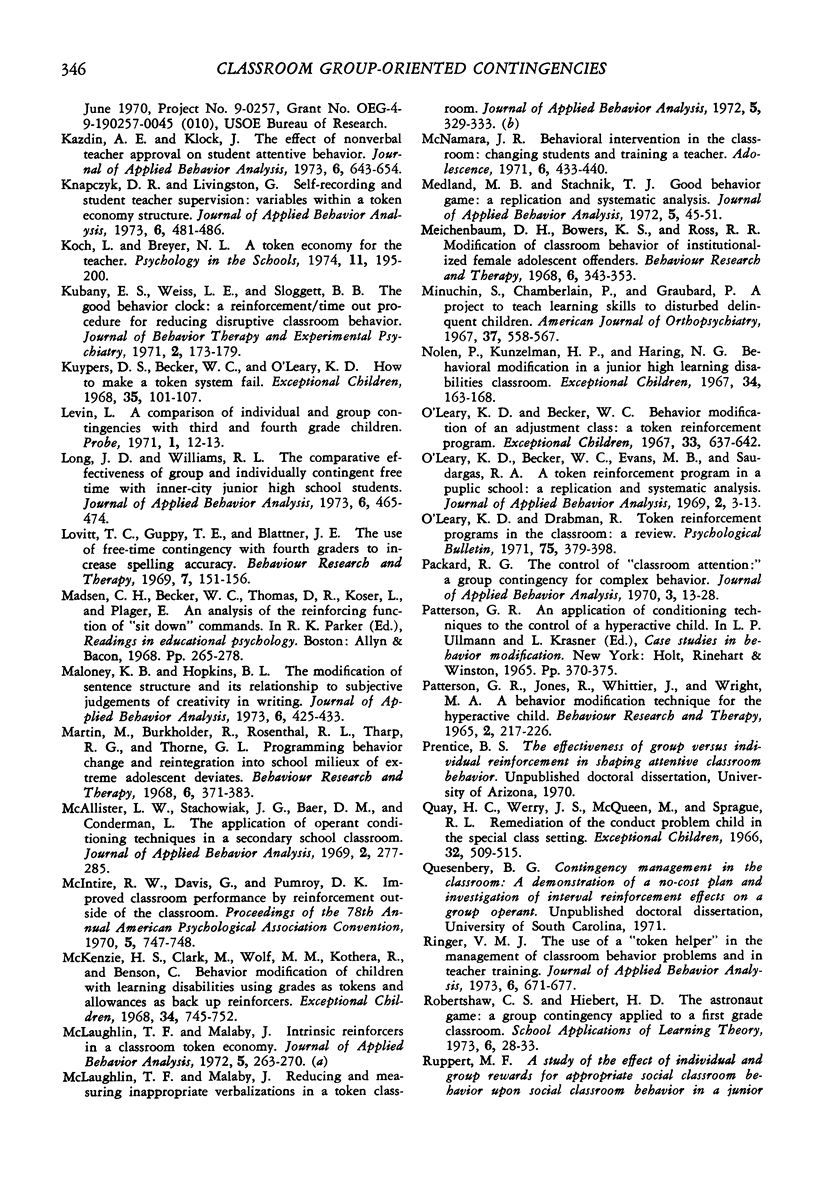Full text
PDF






Selected References
These references are in PubMed. This may not be the complete list of references from this article.
- Axelrod S. Token reinforcement programs in special classes. Except Child. 1971 Jan;37(5):371–379. doi: 10.1177/001440297103700505. [DOI] [PubMed] [Google Scholar]
- Ayllon T., Roberts M. D. Eliminating discipline problems by strengthening academic performance. J Appl Behav Anal. 1974 Spring;7(1):71–76. doi: 10.1901/jaba.1974.7-71. [DOI] [PMC free article] [PubMed] [Google Scholar]
- BIRNBRAUER J. S., LAWLER J. TOKEN REINFORCEMENT FOR LEARNING. Ment Retard. 1964 Oct;2(5):275–279. [PubMed] [Google Scholar]
- Barrish H. H., Saunders M., Wolf M. M. Good behavior game: effects of individual contingencies for group consequences on disruptive behavior in a classroom. J Appl Behav Anal. 1969 Summer;2(2):119–124. doi: 10.1901/jaba.1969.2-119. [DOI] [PMC free article] [PubMed] [Google Scholar]
- Broden M., Hall R. V., Dunlap A., Clark R. Effects of teacher attention and a token reinforcement system in a junior high school special education class. Except Child. 1970 Jan;36(5):341–349. [PubMed] [Google Scholar]
- Bushell D., Wrobel P. A., Michaelis M. L. Applying "group" contingencies to the classroom study behavior of preschool children. J Appl Behav Anal. 1968 Spring;1(1):55–61. doi: 10.1901/jaba.1968.1-55. [DOI] [PMC free article] [PubMed] [Google Scholar]
- Chadwick B. A., Day R. C. Systematic reinforcement: academic performance of underachieving students. J Appl Behav Anal. 1971 Winter;4(4):311–319. doi: 10.1901/jaba.1971.4-311. [DOI] [PMC free article] [PubMed] [Google Scholar]
- Clark M., Lachowicz J., Wolf M. A pilot basic education program for school dropouts incorporating a token reinforcement system. Behav Res Ther. 1968 May;6(2):183–188. doi: 10.1016/0005-7967(68)90005-3. [DOI] [PubMed] [Google Scholar]
- Coleman R. A conditioning technique applicable to elementary school classrooms. J Appl Behav Anal. 1970 Winter;3(4):293–297. doi: 10.1901/jaba.1970.3-293. [DOI] [PMC free article] [PubMed] [Google Scholar]
- Dietz S. M., Repp A. C. Decreasing classroom misbehavior through the use of DRL schedules of reinforcement. J Appl Behav Anal. 1973 Fall;6(3):457–463. doi: 10.1901/jaba.1973.6-457. [DOI] [PMC free article] [PubMed] [Google Scholar]
- Drabman R. S., Spitalnik R., O'Leary K. D. Teaching self-control to disruptive children. J Abnorm Psychol. 1973 Aug;82(1):10–16. doi: 10.1037/h0034981. [DOI] [PubMed] [Google Scholar]
- Drabman R., Spitalnik R., Spitalnik K. Sociometric and disruptive behavior as a function of four types of token reinforcement programs. J Appl Behav Anal. 1974 Spring;7(1):93–101. doi: 10.1901/jaba.1974.7-93. [DOI] [PMC free article] [PubMed] [Google Scholar]
- Evans G. W., Oswalt G. L. Acceleration of academic progress through the manipulation of peer influence. Behav Res Ther. 1968 May;6(2):189–195. doi: 10.1016/0005-7967(68)90006-5. [DOI] [PubMed] [Google Scholar]
- Ferritor D. E., Buckholdt D., Hamblin R. L., Smith L. The noneffects of contingent reinforcement for attending behavior on work accomplished. J Appl Behav Anal. 1972 Spring;5(1):7–17. doi: 10.1901/jaba.1972.5-7. [DOI] [PMC free article] [PubMed] [Google Scholar]
- Glynn E. L. Classroom applications of self-determined reinforcement. J Appl Behav Anal. 1970 Summer;3(2):123–132. doi: 10.1901/jaba.1970.3-123. [DOI] [PMC free article] [PubMed] [Google Scholar]
- Glynn E. L., Thomas J. D., Shee S. M. Behavioral self-control of on-task behavior in an elementary classroom. J Appl Behav Anal. 1973 Spring;6(1):105–113. doi: 10.1901/jaba.1973.6-105. [DOI] [PMC free article] [PubMed] [Google Scholar]
- Graubard P. S. Utilizing the group in teaching disturbed delinquents to learn. Except Child. 1969 Dec;36(4):267–272. [PubMed] [Google Scholar]
- HOMME L. E., DEBACA P. C., DEVINE J. V., STEINHORST R., RICKERT E. J. USE OF THE PREMACK PRINCIPLE IN CONTROLLING THE BEHAVIOR OF NURSERY SCHOOL CHILDREN. J Exp Anal Behav. 1963 Oct;6:544–544. doi: 10.1901/jeab.1963.6-544. [DOI] [PMC free article] [PubMed] [Google Scholar]
- Hall R. V., Fox R., Willard D., Goldsmith L., Emerson M., Owen M., Davis F., Porcia E. The teacher as observer and experimenter in the modification of disputing and talking-out behaviors. J Appl Behav Anal. 1971 Summer;4(2):141–149. doi: 10.1901/jaba.1971.4-141. [DOI] [PMC free article] [PubMed] [Google Scholar]
- Hall R. V., Lund D., Jackson D. Effects of teacher attention on study behavior. J Appl Behav Anal. 1968 Spring;1(1):1–12. doi: 10.1901/jaba.1968.1-1. [DOI] [PMC free article] [PubMed] [Google Scholar]
- Hall R. V., Panyan M., Rabon D., Broden M. Instructing beginning teachers in reinforcement procedures which improve classroom control. J Appl Behav Anal. 1968 Winter;1(4):315–322. doi: 10.1901/jaba.1968.1-315. [DOI] [PMC free article] [PubMed] [Google Scholar]
- Haring N. G., Hauck M. A. Improved learning conditions in the establishment of reading skills with disabled readers. Except Child. 1969 Jan;35(5):341–352. [PubMed] [Google Scholar]
- Harris V. W., Sherman J. A. Use and analysis of the "Good Behavior Game" to reduce disruptive classroom behavior. J Appl Behav Anal. 1973 Fall;6(3):405–417. doi: 10.1901/jaba.1973.6-405. [DOI] [PMC free article] [PubMed] [Google Scholar]
- Herman S. H., Tramontana J. Instructions and group versus individual reinforcement in modifying disruptive group behavior. J Appl Behav Anal. 1971 Summer;4(2):113–119. doi: 10.1901/jaba.1971.4-113. [DOI] [PMC free article] [PubMed] [Google Scholar]
- Hewett F. M., Taylor F. D., Artuso A. A. The Santa Monico project: evaluation of an engineered classroom design with emotionally disturbed children. Except Child. 1969 Mar;35(7):523–529. [PubMed] [Google Scholar]
- Hopkins B. L., Schutte R. C., Garton K. L. The effects of access to a playroom on the rate and quality of printing and writing of first and second-grade students. J Appl Behav Anal. 1971 Summer;4(2):77–87. doi: 10.1901/jaba.1971.4-77. [DOI] [PMC free article] [PubMed] [Google Scholar]
- Kazdin A. E., Klock J. The effect of nonverbal teacher approval on student attentive behavior. J Appl Behav Anal. 1973 Winter;6(4):643–654. doi: 10.1901/jaba.1973.6-643. [DOI] [PMC free article] [PubMed] [Google Scholar]
- Knapczyk D. R., Livingston G. Self-recording and student teacher supervision: variables within a token economy structure. J Appl Behav Anal. 1973 Fall;6(3):481–486. doi: 10.1901/jaba.1973.6-481. [DOI] [PMC free article] [PubMed] [Google Scholar]
- Long J. D., Williams R. L. The comparative effectiveness of group and individually contingent free time with inner-city junior high school students. J Appl Behav Anal. 1973 Fall;6(3):465–474. doi: 10.1901/jaba.1973.6-465. [DOI] [PMC free article] [PubMed] [Google Scholar]
- Maloney K. B., Hopkins B. L. The modification of sentence structure and its relationship to subjective judgements of creativity in writing. J Appl Behav Anal. 1973 Fall;6(3):425–433. doi: 10.1901/jaba.1973.6-425. [DOI] [PMC free article] [PubMed] [Google Scholar]
- Martin M., Burkholder R., Rosenthal T. L., Tharp R. G., Thorne G. L. Programming behavior change and reintegration into school milieux of extreme adolescent deviates. Behav Res Ther. 1968 Aug;6(3):371–383. doi: 10.1016/0005-7967(68)90070-3. [DOI] [PubMed] [Google Scholar]
- McAllister L. W., Stachowiak J. G., Baer D. M., Conderman L. The application of operant conditioning techniques in a secondary school classroom. J Appl Behav Anal. 1969 Winter;2(4):277–285. doi: 10.1901/jaba.1969.2-277. [DOI] [PMC free article] [PubMed] [Google Scholar]
- McKenzie H. S., Clark M., Wolf M. M., Kothera R., Benson C. Behavior modification of children with learning disabilities using grades as tokens and allowances as back up reinforcers. Except Child. 1968 Summer;34(10):745–752. [PubMed] [Google Scholar]
- McLaughlin T. F., Malaby J. Intrinsic reinforcers in a classroom token economy. J Appl Behav Anal. 1972 Fall;5(3):263–270. doi: 10.1901/jaba.1972.5-263. [DOI] [PMC free article] [PubMed] [Google Scholar]
- McLaughlin T., Malaby J. Reducing and measuring inappropriate verbalizations in a token classroom. J Appl Behav Anal. 1972 Fall;5(3):329–333. doi: 10.1901/jaba.1972.5-329. [DOI] [PMC free article] [PubMed] [Google Scholar]
- Medland M. B., Stachnik T. J. Good-behavior game: a replication and systematic analysis. J Appl Behav Anal. 1972 Spring;5(1):45–51. doi: 10.1901/jaba.1972.5-45. [DOI] [PMC free article] [PubMed] [Google Scholar]
- Meichenbaum D. H., Bowers K. S., Ross R. R. Modiciation of classroom behavior of institutionalized female adolescent offenders. Behav Res Ther. 1968 Aug;6(3):343–353. doi: 10.1016/0005-7967(68)90067-3. [DOI] [PubMed] [Google Scholar]
- Minuchin S., Chamberlain P., Graubard P. A project to teach learning skills to disturbed, delinquent children. Am J Orthopsychiatry. 1967 Apr;37(3):558–567. doi: 10.1111/j.1939-0025.1967.tb00494.x. [DOI] [PubMed] [Google Scholar]
- Nolen P. A., Kunzelmann H. P., Haring N. G. Behavioral modification in a junior high learning disabilities classroom. Except Child. 1967 Nov;34(3):163–168. [PubMed] [Google Scholar]
- O'Leary K. D., Becker W. C. Behavior modification of an adjustment class: a token reinforcement program. Except Child. 1967 May;33(9):637–642. [PubMed] [Google Scholar]
- O'leary K. D., Becker W. C., Evans M. B., Saudargas R. A. A token reinforcement program in a public school: a replication and systematic analysis. J Appl Behav Anal. 1969 Spring;2(1):3–13. doi: 10.1901/jaba.1969.2-3. [DOI] [PMC free article] [PubMed] [Google Scholar]
- Packard R. G. The control of "classroom attention": a group contingency for complex behavior. J Appl Behav Anal. 1970 Spring;3(1):13–28. doi: 10.1901/jaba.1970.3-13. [DOI] [PMC free article] [PubMed] [Google Scholar]
- Quay H. C., Werry J. S., McQueen M., Sprague R. L. Remediation of the conduct problem child in the special class setting. Except Child. 1966 Apr;32(8):509–515. doi: 10.1177/001440296603200801. [DOI] [PubMed] [Google Scholar]
- Ringer V. M. The use of a "token helper" in the management of classroom behavior problems and in teacher training. J Appl Behav Anal. 1973 Winter;6(4):671–677. doi: 10.1901/jaba.1973.6-671. [DOI] [PMC free article] [PubMed] [Google Scholar]
- Schmidt G. W., Ulrich R. E. Effects of group contingent events upon classroom noise. J Appl Behav Anal. 1969 Fall;2(3):171–179. doi: 10.1901/jaba.1969.2-171. [DOI] [PMC free article] [PubMed] [Google Scholar]
- Schutte R. C., Hopkins B. L. The effects of teacher attention on following instructions in a kindergarten class. J Appl Behav Anal. 1970 Summer;3(2):117–122. doi: 10.1901/jaba.1970.3-117. [DOI] [PMC free article] [PubMed] [Google Scholar]
- Sulzbacher S. I., Houser J. E. A tactic to eliminate disruptive behaviors in the classroom: group contingent consequences. Am J Ment Defic. 1968 Jul;73(1):88–90. [PubMed] [Google Scholar]
- Walker H. M., Buckley N. K. Programming generalization and maintenance of treatment effects across time and across settings. J Appl Behav Anal. 1972 Fall;5(3):209–224. doi: 10.1901/jaba.1972.5-209. [DOI] [PMC free article] [PubMed] [Google Scholar]
- Wasik B. H. The application of Premack's generalization on reinforcement to the management of classroom behavior. J Exp Child Psychol. 1970 Aug;10(1):33–43. doi: 10.1016/0022-0965(70)90041-x. [DOI] [PubMed] [Google Scholar]
- Willis J., Crowder J. A portable device for group modification of classroom attending behavior. J Appl Behav Anal. 1972 Summer;5(2):199–202. doi: 10.1901/jaba.1972.5-199. [DOI] [PMC free article] [PubMed] [Google Scholar]
- Wilson C. W., Hopkins B. L. The effects of contingent music on the intensity of noise in junior high home economics classes. J Appl Behav Anal. 1973 Summer;6(2):269–275. doi: 10.1901/jaba.1973.6-269. [DOI] [PMC free article] [PubMed] [Google Scholar]
- Wolf M. M., Giles D. K., Hall R. V. Experiments with token reinforcement in a remedial classroom. Behav Res Ther. 1968 Feb;6(1):51–64. doi: 10.1016/0005-7967(68)90042-9. [DOI] [PubMed] [Google Scholar]
- Wolf M. M., Hanley E. L., King L. A., Lachowicz J., Giles D. K. The timer-game: a variable interval contingency for the management of out-of-seat behavior. Except Child. 1970 Oct;37(2):113–117. [PubMed] [Google Scholar]
- Zimmerman E. H., Zimmerman J., Russell C. D. Differential effects of token reinforcement on instruction-following behavior in retarded students instructed as a group. J Appl Behav Anal. 1969 Summer;2(2):101–112. doi: 10.1901/jaba.1969.2-101. [DOI] [PMC free article] [PubMed] [Google Scholar]


